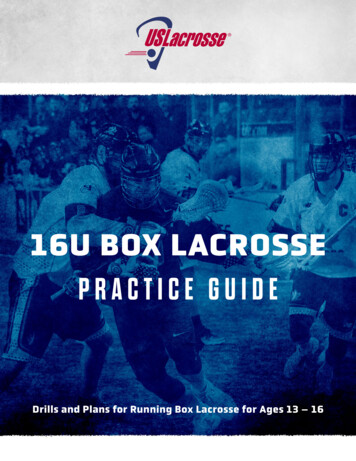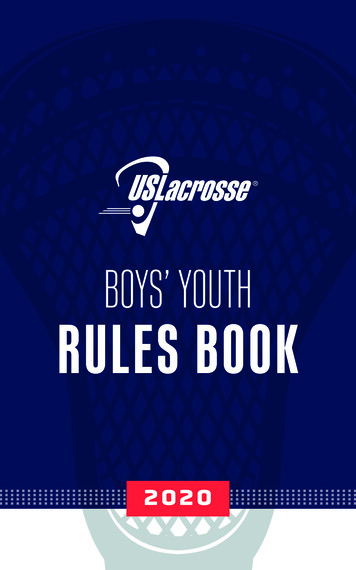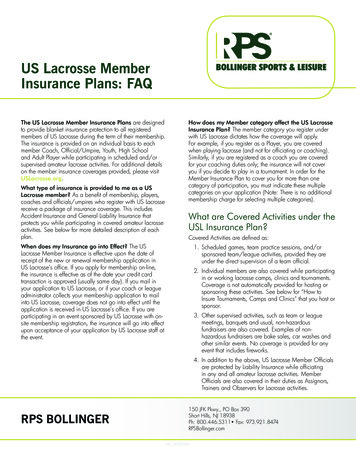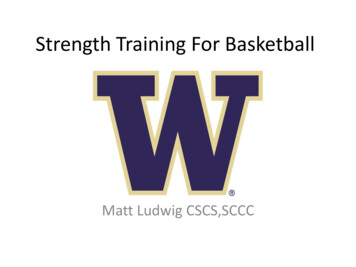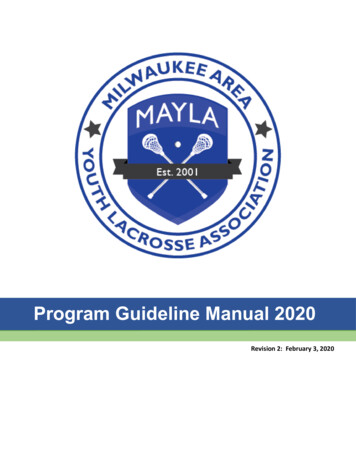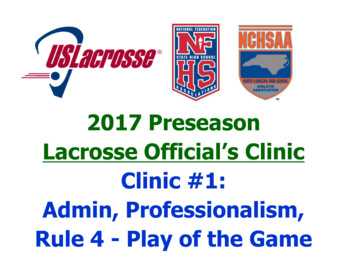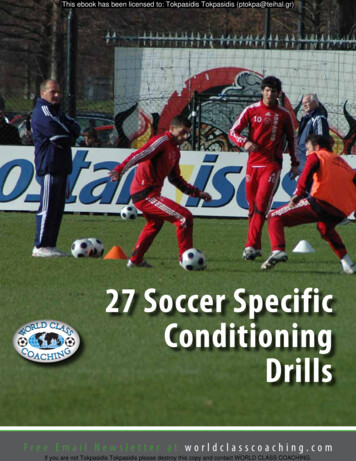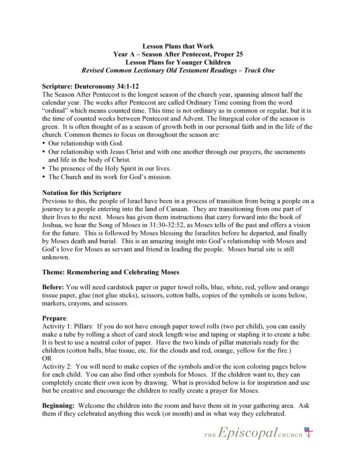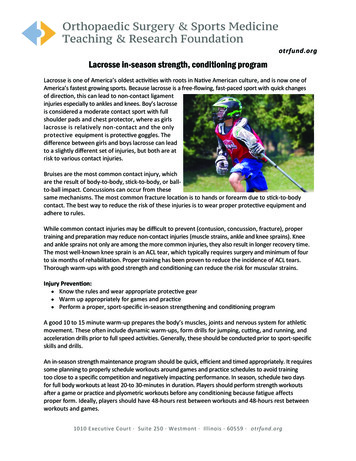
Transcription
otrfund.orgLacrosse in-season strength, conditioning programLacrosse is one of America’s oldest activities with roots in Native American culture, and is now one ofAmerica’s fastest growing sports. Because lacrosse is a free-flowing, fast-paced sport with quick changesof direction, this can lead to non-contact ligamentinjuries especially to ankles and knees. Boy’s lacrosseis considered a moderate contact sport with fullshoulder pads and chest protector, where as girlslacrosse is relatively non-contact and the onlyprotective equipment is protective goggles. Thedifference between girls and boys lacrosse can leadto a slightly different set of injuries, but both are atrisk to various contact injuries.Bruises are the most common contact injury, whichare the result of body-to-body, stick-to-body, or ballto-ball impact. Concussions can occur from thesesame mechanisms. The most common fracture location is to hands or forearm due to stick-to-bodycontact. The best way to reduce the risk of these injuries is to wear proper protective equipment andadhere to rules.While common contact injuries may be difficult to prevent (contusion, concussion, fracture), propertraining and preparation may reduce non-contact injuries (muscle strains, ankle and knee sprains). Kneeand ankle sprains not only are among the more common injuries, they also result in longer recovery time.The most well-known knee sprain is an ACL tear, which typically requires surgery and minimum of fourto six months of rehabilitation. Proper training has been proven to reduce the incidence of ACL tears.Thorough warm-ups with good strength and conditioning can reduce the risk for muscular strains.Injury Prevention: Know the rules and wear appropriate protective gear Warm up appropriately for games and practice Perform a proper, sport-specific in-season strengthening and conditioning programA good 10 to 15 minute warm-up prepares the body’s muscles, joints and nervous system for athleticmovement. These often include dynamic warm-ups, form drills for jumping, cutting, and running, andacceleration drills prior to full speed activities. Generally, these should be conducted prior to sport-specificskills and drills.An in-season strength maintenance program should be quick, efficient and timed appropriately. It requiressome planning to properly schedule workouts around games and practice schedules to avoid trainingtoo close to a specific competition and negatively impacting performance. In season, schedule two daysfor full body workouts at least 20-to 30-minutes in duration. Players should perform strength workoutsafter a game or practice and plyometric workouts before any conditioning because fatigue affectsproper form. Ideally, players should have 48-hours rest between workouts and 48-hours rest betweenworkouts and games.1010 Executive Court · Suite 250 · Westmont · Illinois · 60559 · otrfund.org
ExercisesGroup 1SetsTime/RepsDetailsAgility Run (Cones)42NO REST. Perform Clap Pushupsimmediately after finishing Agility ConesClap Pushups310 to 30 secondsRest 30 seconds before starting nextAgility Run setRest 2 minutes between group exercisesGroup 2SetsTime/RepsDetailsLateral Skater Hops320 to 30 secondsNO REST. Perform Plank with Arm Rowimmediately after finishing Skater HopsPlank with Arm Row21 minuteRest 30 seconds before starting next setof Lateral Skater HopsRest 2 minutes between group exercisesGroup 3SetsTime/RepsDetailsSquat Jumps with Stick320 to 30 secondsNO REST. Perform Plank Rotationsimmediately after finishing Squat JumpsPlank Rotations21 minuteRest 30 seconds before starting next setof Squat Jumps with StickRest 2 minutes between group exercisesGroup 4SetsTime/RepsDetailsSplit Lunge Jumps3NO REST. Perform Side Plank with Leg20 to 30 seconds Raise immediately after finishing SplitLunge JumpsSide Plank(with Leg Raise)230 to 40 secondsRest 30 seconds before starting next setof Split Lunge JumpsRest 2 minutes between group exercisesIMPORTANTAs with any exercise program, it is essential to maintain proper technique during the warm-up and exercise toreceive maximum benefits and prevent injury. Seek professional help on arm swing, jumping, and landingmechanics to learn pointers and stay injury free.2
Group 1Agility Run: Four SquareSetTime/RepsRest12NO REST beforestarting pushups1. Set cones or markers to form a square 10 yards apart.2. Split the players into groups. One group per every square group of cones.3. Have the groups run each drill pattern direction twice with their lacrossestick and ball to complete one set.4. Perform clap pushups for 10 to 30 seconds before moving on to nextagility course.3
Group 1Agility Run: Bow TieSetsTime/RepsRest12NO REST beforestarting pushups1. Set cones or markers to form a square 10 yards apart.2. Split the players into groups. One group per every group of four cones.3. Have the groups run each drill pattern direction twice with their lacrosse stickand ball to complete one set.4. Perform clap pushups for 10 to 30 seconds before moving to the nextagility course.4
Group 1Agility Run: Figure EightsSetsTime/RepsRest12NO REST beforestarting pushupsSTART1. Set cones or markers to form a square 10 yards apart.2. Split the players into groups, one group per every group of eight cones.3. Have the groups run each drill pattern direction twice with their lacrosse stickand ball to complete one set.4. Perform clap pushups for 10 to 30 seconds before moving on to next agilitycourse.5
Group 1Agility Run: Offense/DefenseSetsTime/RepsRest12NO REST beforestarting pushups1. Set cones or markers to form a square 10 yards apart. Place a 5th cone in thecenter of the square formed by the four cones.2. Split the players into groups. Two groups per every five cones.3. Have the groups run each drill pattern direction twice with their lacrosse stickand ball to complete one set.4. When completed, allow players to rest two minutes before startingGroup 2 exercises.6
Group 1123Clap PushupsSetsTimeRest310 to 30seconds30 seconds beforenext agility drill1. Assume a standard push-up position*with your hands outside your shouldersand feet hip-width apart.2. Begin by bending your elbows andlowering your chest down to theground, pause, then explode off theground, pushing as hard as you can sothat your hands come off the ground.3. Immediately clap your hands togetherquickly in the air and return to thestarting position.4. Repeat steps one through three untiltime expires.5. Rest 30 seconds and perform nextagility drill. If push ups from a standard position are toodifficult, modify to a kneeling position keepingknees bent and feet up when lowering andpushing off to perform clap.7
Group 2Lateral Skater HopsSetsTime/RepsRest320-30 secondsNone―start Plank Rowexercise after finishingLateral Hops1231. Using lines on the field, or cones, mark a distance abouttwice the width of your shoulders. Stand at the rightline (cone) on your right foot with your right hip and4knee slightly bent, back flat and chest up.2. Jump as far as possible toward the left line (cone).3. Land on the ball of your left foot with your left hip andknee slightly bent to absorb the impact and to controlthe landing.4. Immediately jump off your left back toward the right line (cone) in order tocomplete one set and return to the start.5. Continue jumping back and forth in this manner until time expires to completeone set.6. Perform plank row exercise right after completing lateral skater hops. Donot rest.7. After completing three sets of Lateral Skater Hops, rest two minutes and thenmove on to Group 3 exercises.8
Group 2Plank with Arm RowSetsTime/RepsRest21 minuteRest 30 seconds andrepeat Lateral Hops12341. Assume the plank position as shown.2. While maintaining the plank position, bend your right elbow and liftyour right hand off the ground.3. Hold the position for one second, then return to the starting position.4. Repeat the exercise with your left arm.5. Continue the exercise alternating arms until time expires to completeone set.6. Upon finishing, rest 30 seconds and perform Lateral Skater Hops.9
Group 3Squat Jump with StickSets31Time/RepsRestNone―start Plank20-30 seconds Rotation exercise afterfinishing Squat Jumps231. Stand with both feet shoulder-width apart, knees bent and both hands holding alacrosse stick in front of you.2. Jump straight up thrusting your hands and stick up over your head to help youget as high off the ground as possible.3. Land softly on both feet with both knees bent returning to the starting position.4. Continue jumping in this manner until time expires to complete one set.5. Perform Plank Rotation exercise immediately after completing Squat Jumps.Do not rest.6. After completing three sets, rest two minutes and move on to Group 4 exercises.10
Group 3Side Plank Rotations1SetsTime/RepsRest21 minuteRest 30 seconds beforerepeating Squat Jump21. Begin in a push up position. Keep yourbody straight and back flat.2. Lift your left hand off the ground, rotating your left hip until your left arm isextended overhead and in line with your right arm. Your chest should beperpendicular to the ground and spine in a neutral position.3. Return to a pushup position.4. Repeat the exercise rotating to the right.5. Continue to repeat the exercise alternating the rotation direction until timeexpires to complete one set.6. Rest 30 seconds and resume Squat Jump.3411
Group 41Split Lunge JumpsSetsTime/RepsRest320-30 secondsNone―start PlankRotation exercise afterfinishing Squat Jumps231. Start in a lunge position with your arms at your side.2. Jump straight up as high as possible pushing off your front heel and back toe.3. While in the air, switch legs so you land with the other foot forward.Remember to keep your chest up.4. Bend the back knee as you land softly on the ground and immediatelyexplode back into the air landing with the other foot forward.5. Continue jumping in this manner until time expires to complete one set.6. Perform Side Plank with Leg Raise exercise immediately after completing SplitLunge Jumps. Do not rest.7. You are finished with the strength and conditioning program after completingthree sets of the Split Lunge Jumps and Side Plank with Leg Raises.12
Group 4Side Plank (with Leg Raise)Sets21Time/RepsRest30-40 secondsRest 30 seconds, thenresume Split LungeJump21. Begin the exercise by lying on your left side, with your left arm bent so yourelbow is directly under your shoulder and your feet are stacked on top of oneanother. Lift your hips off the ground until your body is in a straight line. Keepyour hips forward and inline with your legs and torso.2. Once you are able to hold this position for 30 to 40 seconds, raise your rightleg. Do not let your hips rotate forward or backward. Hold for 15 seconds.3. Lower your leg and change to your right side. Repeat the exercise.4. Rest 30 seconds, then resume Split Lunge Jump exercise.13
Sports Medicine, Injury Prevention Expertise Provided by Team ChudikThe goal of Dr. Steven Chudik and his health performance team is to provide you and yourathletes with reliable and proven training information so they can compete and perform attheir highest level and ability and limit the risk for injury.This program is based upon research which found athletes need to incorporate specificexercises into their weekly training schedules not only to maintain strength, but moreimportant, help minimize injuries. To maximize the benefit of this program, it is important forplayers to follow the recommended programs and maintain proper form at all times. Failure to do so could result in an injury.Steven C. Chudik, MDBoard-certified physician in orthopaedics and sports medicine withthe Steven Chudik Shoulder and Knee Injury Clinic, Dr. Chudik is thefounder and president of the Orthopaedic Sports Medicine Teaching andResearch Foundation (OTRF) and an associate professor at Loyola Schoolof Medicine.Keith Tesch, CSCS, CNTFor more than ten years, Keith has been in the fitness industry working as apersonal trainer and sports performance specialist, a position he currentlyholds. During the past five years, his focus has been helping individualsregain their strength and range of motion through research-basedprograms.James Wolf, PT, DPT, OCSA licensed physical therapist and board-certified orthopaedic clinicalspecialist, James has a doctor of physical therapy degree fromNorthwestern University. In his current position, he treats a variety oforthopaedic patients including competitive and recreational athletes.Erin Scheiber, PT, DPT, ATCErin is a licensed physical therapist, certified athletic trainer and physicaltherapy clinic director with a special interest in post-operative ACL rehabilitationand non-operative/operative shoulder rehabilitation. She soon will be addingcertified manual therapist (COMT) credentials to her expertise.14
Sports Injury Medicine ClinicTo assist coaches, athletic trainers, players and parents, Dr. Chudik has a Monday evening Sports MedicineInjury Clinic in his Westmont office. During this time, athletes can be seen and treated by Dr. Chudik, aboard-certified orthopaedic surgeon and sports medicine physician. An added benefit to athletes seen inthe Clinic is the availability of an X-ray suite and an open-bore, high-field magnetic resonance imaging (MRI)machine. This onsite diagnostic capability eliminates issues associated with appointments, delayed diagnosisand treatment. To request an appointment with Dr. Chudik, call 630-324-0402.About OTRFSteven Chudik, orthopaedic surgeon and sports medicine physician with the Steven Chudik Shoulder andKnee Injury Clinic, founded the Orthopaedic Surgery and Sports Medicine Teaching and Research Foundation(OTRF) in 2007. OTRF is a nonprofit, 501(c)(3) organization dedicated to funding research and education forthe purpose of keeping people active and healthy.Dr. Chudik has seen a growing demand by patients, athletic trainers and clinicians for up-to-date medicalinformation and unbiased research on injury prevention—as well as information on injuries, arthritis(wear and tear) to joints, cartilage, tendons, ligaments, etc. To fulfill these requests, OTRF producesand distributes an E-newsletter, shares information about health performance-related issues likenutrition and fitness, hosts athletic training educational programs, conducts seminars for healthcareproviders and the community and most important, funds unbiased research and development particularlyin emerging areas such as arthroscopic and minimally invasive surgery for injuries to the meniscus,labrum, rotator cuff, ACL and cartilage.Lacrosse in-season strength,conditioning programJames Wolf, PT, DPT, OCSAuthor & EditorKeith Tesch, CSCS, CNTSally Wilcox, MS, ATAC/LErin Scheiber, PT, DPT, ATCAthletic ConsultantsSteven Chudik, MDPublisherotrfund.orgHowever, none of this is possible without ongoing financialsupport. We are extremely grateful to all those who havecontributed in the past. Many donations come frompatients or their family members who benefited fromDr. Chudik's orthopaedic and sports medicine expertise. Ifyou are interested in helping OTRF fund education and researchprograms, please contact Dr. Chudik at 630-324-0402 orvisit otrfund.org and click on the contributions tab at the top.Also, many companies sponsor programs that match charitabledonations made by employees. Some even match retirees’and/or spouses’ donations. Matching gift programs are a greatway to double your generosity. Regardless of the amount,every contribution helps make a difference today and foryears to come. 2017 Orthopaedic Surgery and Sports Medicine Teaching and ResearchFoundation (OTRF). All rights reserved. For reprints or copy permission, contactOTRF at stevenchudikmd@gmail.com/.15
Important NoticeNot all exercises are suitable for everyone. Consultyour physician before beginning this or any otherexercise program. Also, always warm up for severalminutes before beginning a workout and NEVERexercise beyond the level at which you feelcomfortable. If at any time you feel you areSports Medicine Injury ClinicMonday EveningsCall 630-324-0402Ask for Dr. Chudikexercising beyond your current fitness abilities, orfeel discomfort, discontinue exercise immediatelyand reconsider your participation in this program.The in-season lacrosse stretching and conditioningprogram provided in this publication should not beattempted by anyone who does not meet minimumfitness requirements, or who has a history of hip,knee, ankle, shoulder, elbow, wrist or spinal (neckor back) problems. THIS WARNING IS NOT TO BEDISCOUNTED. There are many other fitnessalternatives if you have weaknesses, or are proneto injuries. The user assumes all risks of injury inthe use of this program.1010 Executive Court, Suite 250Westmont, IL 60559Sign Up Today!Don’t miss another issueof Active Bones, a monthly E-newsletter fromOTRF. Each issue is filledwith information to helpyou stay healthy and livean active life. Simplyemail: contactus@chudikmd.comto receive the next issueof Active Bones.
for full body workouts at least 20-to 30-minutes in duration. Players should perform strength workouts after a game or practice and plyometric workouts before any conditioning because fatigue affects proper form. Ideally, players should have 48-hours rest between workouts and 4
